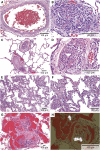Features and Outcomes of Methamphetamine-associated Pulmonary Arterial Hypertension
- PMID: 28934596
- PMCID: PMC5855067
- DOI: 10.1164/rccm.201705-0943OC
Features and Outcomes of Methamphetamine-associated Pulmonary Arterial Hypertension
Abstract
Rationale: Although amphetamines are recognized as "likely" agents to cause drug- and toxin-associated pulmonary arterial hypertension (PAH), (meth)amphetamine-associated PAH (Meth-APAH) has not been well described.
Objectives: To prospectively characterize the clinical presentation, histopathology, and outcomes of Meth-APAH compared with those of idiopathic PAH (iPAH).
Methods: We performed a prospective cohort study of patients with Meth-APAH and iPAH presenting to the Stanford University Pulmonary Hypertension Program between 2003 and 2015. Clinical, pulmonary angiography, histopathology, and outcomes data were compared. We used data from the Healthcare Cost and Utilization Project to estimate the epidemiology of PAH in (meth)amphetamine users hospitalized in California.
Measurements and main results: The study sample included 90 patients with Meth-APAH and 97 patients with iPAH. Patients with Meth-APAH were less likely to be female, but similar in age, body mass index, and 6-minute-walk distance to patients with iPAH. Patients with Meth-APAH reported more advanced heart failure symptoms, had significantly higher right atrial pressure (12.7 ± 6.8 vs. 9.8 ± 5.1 mm Hg; P = 0.001), and had lower stroke volume index (22.2 ± 7.1 vs. 25.5 ± 8.7 ml/m2; P = 0.01). Event-free survival in Meth-APAH was 64.2%, 47.2%, and 25% at 2.5, 5, and 10 years, respectively, representing more than double the risk of clinical worsening or death compared with iPAH (hazard ratio, 2.04; 95% confidence interval, 1.28-3.25; P = 0.003) independent of confounders. California data demonstrated a 2.6-fold increase in risk of PAH diagnosis in hospitalized (meth)amphetamine users.
Conclusions: Meth-APAH is a severe and progressive form of PAH with poor outcomes. Future studies should focus on mechanisms of disease and potential therapeutic considerations.
Keywords: methamphetamine; outcomes; pulmonary arterial hypertension.
Figures






Comment in
-
Amphetamine Derivatives and the Risk of Pulmonary Arterial Hypertension. A New Chapter of the Story.Am J Respir Crit Care Med. 2018 Mar 15;197(6):704-706. doi: 10.1164/rccm.201709-1962ED. Am J Respir Crit Care Med. 2018. PMID: 29043836 No abstract available.
-
Amphetamine Derivatives and the Risk of Pulmonary Arterial Hypertension: A Missing Chapter of the Story?Am J Respir Crit Care Med. 2018 May 15;197(10):1364. doi: 10.1164/rccm.201711-2319LE. Am J Respir Crit Care Med. 2018. PMID: 29272590 No abstract available.
-
Reply to Frachon: Amphetamine Derivatives and the Risk of Pulmonary Arterial Hypertension: A Missing Chapter of the Story?Am J Respir Crit Care Med. 2018 May 15;197(10):1364-1365. doi: 10.1164/rccm.201712-2483LE. Am J Respir Crit Care Med. 2018. PMID: 29272591 No abstract available.
Similar articles
-
Clinical Differences and Outcomes between Methamphetamine-associated and Idiopathic Pulmonary Arterial Hypertension in the Pulmonary Hypertension Association Registry.Ann Am Thorac Soc. 2021 Apr;18(4):613-622. doi: 10.1513/AnnalsATS.202007-774OC. Ann Am Thorac Soc. 2021. PMID: 33064950 Free PMC article.
-
Pulmonary arterial capacitance in children with idiopathic pulmonary arterial hypertension and pulmonary arterial hypertension associated with congenital heart disease: relation to pulmonary vascular resistance, exercise capacity, and survival.Am Heart J. 2011 Sep;162(3):562-8. doi: 10.1016/j.ahj.2011.06.014. Epub 2011 Aug 11. Am Heart J. 2011. PMID: 21884877
-
Methamphetamine and the risk of pulmonary arterial hypertension.Curr Opin Pulm Med. 2018 Sep;24(5):416-424. doi: 10.1097/MCP.0000000000000513. Curr Opin Pulm Med. 2018. PMID: 30036313 Free PMC article. Review.
-
Clinical Characteristics and Outcome of Methamphetamine-Associated Pulmonary Arterial Hypertension and Dilated Cardiomyopathy.JACC Heart Fail. 2018 Mar;6(3):209-218. doi: 10.1016/j.jchf.2017.10.006. JACC Heart Fail. 2018. PMID: 29496022
-
Treatment of pulmonary arterial hypertension in connective tissue disease.Drugs. 2012 May 28;72(8):1039-56. doi: 10.2165/11633390-000000000-00000. Drugs. 2012. PMID: 22621693 Review.
Cited by
-
Sex-dependent right ventricular hypertrophic gene changes after methamphetamine treatment in mice.Eur J Pharmacol. 2021 Jun 5;900:174066. doi: 10.1016/j.ejphar.2021.174066. Epub 2021 Mar 28. Eur J Pharmacol. 2021. PMID: 33789156 Free PMC article.
-
Nupr1-mediated vascular smooth muscle cell phenotype transformation involved in methamphetamine induces pulmonary hypertension.Cell Biol Toxicol. 2024 Feb 13;40(1):13. doi: 10.1007/s10565-024-09849-6. Cell Biol Toxicol. 2024. PMID: 38347241 Free PMC article.
-
Sex, Gender, and Sex Hormones in Pulmonary Hypertension and Right Ventricular Failure.Compr Physiol. 2019 Dec 18;10(1):125-170. doi: 10.1002/cphy.c190011. Compr Physiol. 2019. PMID: 31853950 Free PMC article. Review.
-
Successful treatment of pulmonary hypertension due to HIV infection and amphetamine snorting: a case report.Front Med (Lausanne). 2025 Apr 23;12:1556041. doi: 10.3389/fmed.2025.1556041. eCollection 2025. Front Med (Lausanne). 2025. PMID: 40337277 Free PMC article.
-
Cardiomyopathy-Associated Hospital Admissions Among Methamphetamine Users: Geographical and Social Disparities.JACC Adv. 2024 Mar 13;3(7):100840. doi: 10.1016/j.jacadv.2024.100840. eCollection 2024 Jul. JACC Adv. 2024. PMID: 39130045 Free PMC article.
References
-
- United Nations Office on Drugs and Crime. United Nations Office on Drugs and Crime. Vienna, Austria: United Nations Publication; 2012. World drug report 2012.
-
- European Monitoring Centre for Drugs and Drug Addiction. The state of the drugs problem in Europe—annual report 2011. Luxembourg: Publications Office of the European Union; 2011.
-
- Substance Abuse and Mental Health Services Administration. In: Center for Behavioral Health Statistics and Quality, editor. Rockville, MD; 2014. Results from the 2013 National Survey on Drug Use and Health: summary of national findings.
-
- Panenka WJ, Procyshyn RM, Lecomte T, MacEwan GW, Flynn SW, Honer WG, et al. Methamphetamine use: a comprehensive review of molecular, preclinical and clinical findings. Drug Alcohol Depend. 2013;129:167–179. - PubMed
Publication types
MeSH terms
Substances
Grants and funding
- K12 HL089989/HL/NHLBI NIH HHS/United States
- U01 HL107393/HL/NHLBI NIH HHS/United States
- R01 HL087118/HL/NHLBI NIH HHS/United States
- R03 HL133423/HL/NHLBI NIH HHS/United States
- P01 HL108797/HL/NHLBI NIH HHS/United States
- R01 HL139664/HL/NHLBI NIH HHS/United States
- K12 HL120001/HL/NHLBI NIH HHS/United States
- K08 HL105884/HL/NHLBI NIH HHS/United States
- R01 HL134776/HL/NHLBI NIH HHS/United States
- R01 HL113988/HL/NHLBI NIH HHS/United States
- K24 HL103844/HL/NHLBI NIH HHS/United States
- R01 HL074186/HL/NHLBI NIH HHS/United States
- P60 AA006282/AA/NIAAA NIH HHS/United States
LinkOut - more resources
Full Text Sources
Other Literature Sources
Medical

